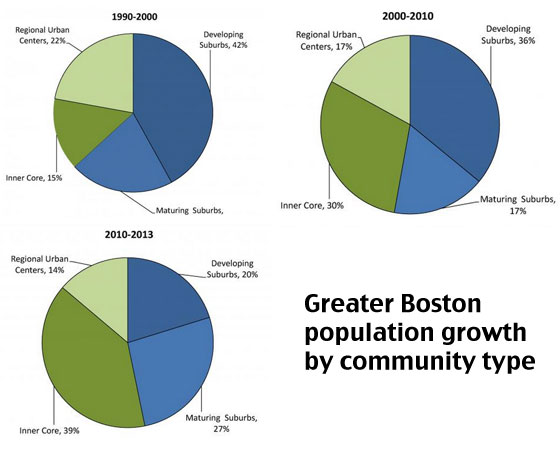Cross-posted from the Frontier Group.

Sommer Mathis said much of what needed to be said about the recent round of “the suburbs are back, baby!” stories on housing trends, including this analysis from Jed Kolko, housing economist at Trulia.com, and the related commentary from Matt Yglesias at Vox. Mathis argues that the concept of a battle for supremacy between cities and suburbs is fundamentally silly, especially at a time in history when the terms "city" and "suburb" each represent a wide variety of built forms and socioeconomic conditions.
There is another problem, however, with these stories, which is that they play into the narrative -- recently championed by the likes of Wendell Cox and Joel Kotkin -- that when it comes to housing trends, little meaningful (other than the recession) has really changed in the United States in recent years. Kolko, for example, states that, after a brief period in which urban population growth outpaced that of the suburbs, "old patterns have returned," while Yglesias states that "the trajectory of American housing growth is still all about the suburbs.” But the "old patterns" have not returned. Far from it.
The old pattern of development, which prevailed during the second half of the 20th century (and the first few years of the 21st), was one of rapid suburbanization characterized by the universal spread of a particular kind of segregated-use, automobile-oriented development known colloquially as "sprawl."
As Kolko notes, suburbs today are adding population a wee bit faster than cities, a shift from earlier this decade when cities were growing a wee bit faster than suburbs. But for most of the 20th century, suburbs weren’t just beating cities by a nose in the hypothetical growth contest, they were trouncing them like Secretariat at the Belmont.
Above is an illustration from my home region of greater Boston. In the 1990s, population growth in the region was almost, in Yglesias's words, "all about the suburbs." During that decade, according to data compiled by the Metropolitan Area Planning Council, more than 60 percent of the region’s population growth took place in the suburbs, and only 15 percent in the "inner core" of Boston and its neighboring cities. And Boston had it relatively good -- some other older cities across the country continued to lose population during the 1990s. By the 2000s, however, the pattern had begun to shift.[1] The share of the region's growth taking place in the "inner core" doubled compared to the previous decade, while the share taking place in suburbs fell to barely more than half. And since 2010, the inner core has accounted for 39 percent of population growth, nearly twice the share of the once-booming "developing suburbs."
To conflate today's mild and tenuous suburban growth advantage over cities with yesterday's rampant suburban sprawl is to lead people to believe that the post-recession future of development is going to look very much like the last decades of the 20th century.
Is there a chance that we could return to the sprawling days of yore? Perhaps. But, as a quick glance at the single-family housing market will show, it hasn’t happened yet. And with the impending, Baby Boomer-led "Great Senior Sell-off" of suburban housing, the improving quality of life in many cities that makes urban living a perfectly rational decision for at least some young families, and the emerging models for successful revitalization of existing suburbs (see Arlington, Virginia), I have my doubts.
The future, I suspect, is going to defy easy generalization. In some rapidly growing metros that still have room to sprawl, you might see renewal of the postwar pattern of new, sprawly suburbs being built at the metropolitan periphery. In other areas, you’ll see reinvestment in "inner ring" suburbs. In still other cases, especially in slower growing metros, you'll see growing suburban decay and decline, a scenario that should give anyone who cares about the environment, social equity, the fate of seniors, or wise use of public resources a case of the howling fantods.
As someone who believes in the potential of cities and wants to see them succeed, I want there to be smart suburban development that enables Millennials who choose suburban living (and there will be a lot of them) to get what they need for themselves and their families, while hopefully not replicating the mistakes of the sprawling past. Which brings us back around again to the point of Mathis's piece: the increasing uselessness of our binary "cities versus suburbs" discourse.
The 21st century has not yet been, and is not likely to be, a mere continuation and extension of the 20th. "Old patterns" have not returned, and in many places, they never will. With the aging of the Baby Boomers, the maturing of the Millennials, and the important changes afoot in both suburbs and cities, we are heading somewhere new and fascinating in the years ahead. Now, we just need a better language with which to talk about it.
[1] There’s another issue with Kolko’s analysis, which I’m perpetuating a bit here, which is treating the period from 2000 to 2010 (or 2013), as though it is one homogeneous block of time. In reality, it was two periods: a period from 2000 to roughly 2007 in which debt-fueled exurban real estate speculation abounded, and a period from 2007 to 2013 of recession and tight credit. Are trend lines that extend across those two periods relevant or useful?





